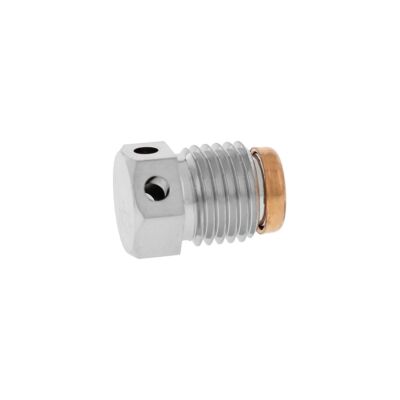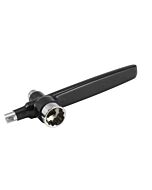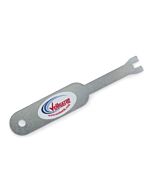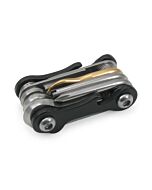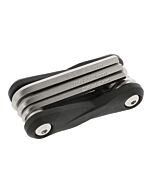PRD Safety Assembly (Burst Disk Kit)
- Nitrox Ready one-piece assembly for safety and convenience
- Several options for pressure ratings
- Ratings are release pressure, not cylinder service pressure
- Compatible with DGX, Dive Rite, Thermo, Sea Elite, XS Scuba, Hollis, and Blue Steel valves
- NOT compatible with Sherwood or Genesis valves
PRD Safety Assembly (Burst Disk Kit)
For use in North America, this Nitrox Ready PRD (Pressure Relief Disk) assembly aka "burst disk" fits the typical 3/8-24 UNF thread PRD openings of all brands of valves sold by Dive Gear Express including DGX and Thermo as well as most other brands such as Dive Rite, Sea Elite, XS Scuba, Hollis, Blue Steel, and late model OMS. However this assembly does NOT fit 1/2-inch PRD openings found on Sherwood, Harrison, Genesis and early OMS brand valves. The one-piece safety assembly eliminates the possibility of mismatched components and reduces the likelihood of accidental incorrect installation of the safety assembly.
Pressure relief disks are described by their release pressure, not the cylinder service pressure. This PRD is clearly marked with the release pressure in PSI on the hex head and requires 100-120 in-lb of torque for installation. If the PRD is installed in the scuba valve too tightly it will rupture prematurely, and if installed not tightly enough it will leak.
Dive Gear Express recommends the safety assembly be replaced by a qualified technician whenever the cylinder is hydro tested and annually if the cylinder is known to have been overfilled.
| Brand | Thermo |
|---|---|
| SKU | SPM-TV3990xx |
| Weight | 0.100000 |
Customer Reviews
Burst Disks in SCUBA Valves Are Not What You Think
In the U.S. at the turn of the twentieth century, a series of boiler explosions caused significant loss of life. The most famous of the accidents, the Grover Shoe Factory disaster in 1905 resulted in stringent safety laws and a national code related to safe operation of boilers but is inclusive of most pressure vessels, including modern portable compressed gas cylinders. All U.S. cylinder valves are required by the Department of Transportation (DOT) to have a pressure release device (PRD) that operates if the pressure exceeds the cylinder test specifications. The design of the PRD used is a non-reclosing rupture type, also called a burst disk assembly. The thickness of a small metal (usually stainless steel or copper) disk in the assembly determines the pressure at which it will rupture, releasing the compressed gas.
In practice, the presence of PRDs in SCUBA valves has proven to be problematic. Over time the thin metal disk can corrode due to frequent exposure to moisture associated with diving activities, causing it to fail and release in the range of the service pressure. Sometimes a valve with burst disk intended for a low pressure cylinder is inadvertently installed in a high pressure cylinder. A PRD also can be incorrectly over torqued during installation, causing premature failure. If the PRD does not fail during or shortly after filling, the under rated or over torqued PRD is almost certain to eventually fail. Mismatched PRDs and cylinders are common, in part because most older PRDs on SCUBA valves are not clearly marked or not marked at all as to their release pressure.
While the PRD is required by archaic law on SCUBA cylinders in the US, the PRD is not present on SCUBA valves in Europe because they are considered a hazard. A PRD failure can be especially dangerous with small scuba cylinders such as pony, bailout, and deco bottles. The sudden and unexpected rupture of the PRD releases a powerful jet of high pressure gas which can propel the relatively small metal scuba cylinder like a rocket and cause it to careen about the immediate area with enormous force. The PRD could, in theory, fail during a dive and cause rapid loss of breathing gas for life support, although this is extremely rare. Some divers, particularly those who over fill their cylinders and/or dive in overhead environments, install a disk rated for a pressure higher than the test pressure of the cylinder or deliberately defeat the PRD using a practice known as 'double disking'.
PRDs are single use devices, if loosened or removed for any reason following installation then they must be discarded and a new unused PRD installed. Proper installation of the PRD requires a torque wrench tool and proper removal of the disk may require an extractor tool, along with correct technique to avoid damage in either case. For these reasons, Dive Gear Express recommends that the cylinder valve be overhauled and a new burst disk be installed by a qualified valve repair technician whenever the cylinder is hydro tested (i.e., every five years) and annually if the cylinder is known to have been overfilled.
Changing a burst disk that has not actually ruptured can be troublesome, especially if the valve has never been pressurized. When a new disk is installed in a valve, the compression of the disk by the hollow retaining nut can cause the edges of the disk to extrude slightly into the threads of the over-pressure outlet on the valve. When the retaining nut is removed, a disk that has never been pressurized (and even some that have) can be a challenge to dislodge and if that's the case then using a small screw extractor is likely the best approach. An alternative method is to first pressurize the valve to the service pressure of the cylinder or the burst disk, whichever is lower. This will cause the edges of the disk to recede slightly from the threads, then drain the cylinder and remove the hollow retaining nut. Once the nut is removed, wrap a towel on the valve and start rapidly pressurizing the cylinder again... the disk should blow out of the valve and be safely captured by the towel. Look down in the outlet to make sure both the disk and the washer underneath it came completely out. Look carefully, if the small washer underneath the disk was made of clear plastic it can be very difficult to see. You should be able to use a brass o-ring pick to carefully remove any components that remain.
